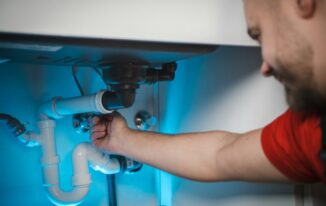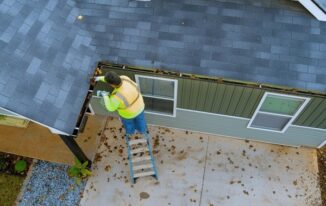If you have a family with young children, you need to make your home kid-friendly. Children are naturally curious and exploratory, which can lead to potential hazards in a home that isn’t childproofed.
A kid-friendly environment allows children to move about freely while offering parents peace of mind. The objective is to create a safe, fun, and engaging atmosphere that fosters growth and learning. Take a look at some practical tips on transforming your living space into a safe and relaxing haven for kids and the whole family.

Choosing Safe Materials and Finishes
The materials and finishes in your home can impact the safety and durability of your kid-friendly environment. Opt for non-toxic paints and finishes, especially in areas where kids spend the most time. You want to look for providers like RMP Finishes that offer quality products suitable for a family environment, even in bundle packaging. This means you won’t have to buy paint, brushes, and finishing creams separately anymore. Regular household paints can contain harmful chemicals that could affect children’s health.
Aside from paints, you should also invest in washable materials, such as machine-washable curtains and upholstery, to keep your space looking fresh and clean. Choose furnishings made from solid, non-toxic materials. To reduce potential hazards, avoid plastics that can break easily and do not introduce harmful chemicals into your environment.
Assessing Potential Hazards
Always evaluate potential hazards throughout your home. As briefly mentioned, there are many common items out there that can pose risks to young children, such as sharp edges on furniture or hazards like small objects that can be swallowed. Take stock of what is in your living space and look for items that might tip over easily or have cords that can be pulled.
The best course of action is to secure heavy furniture to the wall to prevent tipping. You can even switch out lower tables for soft options or provide protective cushioning to sharp corners. Child locks on cabinets containing hazardous materials (cleaning supplies, medication, and batteries) might be a must-have to prevent accidents. Don’t forget to implement soft-close mechanisms on cabinet doors or furniture with rounded edges that minimize the risk of injury. Always prioritize safety over aesthetics: your child’s well-being comes first!
Creating Safe Play Areas
If you want to take safety up a notch, establish designated play areas in your child-friendly home. When children have a specific space to play in, it keeps their activities contained and minimizes the clutter spread throughout the house. Think about setting up a room or a corner with toys that are age-appropriate and safe. This space can be furnished with soft rugs to cushion falls and low shelves to promote independence in selecting toys.
Incorporate sensory play elements, maybe a small ball pit or a chalkboard wall, where kids can express their creativity and learn through play. Make sure that all furniture in this area is safe and free from sharp edges. Consider making use of modular furniture that allows for rearranging as your child grows and their play needs change. Creating an inviting and engaging play area encourages creativity and growth while keeping mom and dad’s stress levels at bay.
Organizing Toys and Supplies
It’s not a secret that a kid-friendly home cannot be cluttered and disorganized. A cluttered space can lead to frustration for parents and accidents for the children, so you should never compromise on having an organizational system in place.
If you have toys scattered all over the floor, storage options such as bins, baskets, and shelves can help keep toys orderly and easily accessible. Label storage containers with words or pictures to assist younger children in learning where to put their toys back. Rotate toys periodically to keep your child’s interest alive without overwhelming them with choices. This is a strategy that helps maintain an organized environment. To further save space in your home, use
multi-functional furniture: benches with hidden storage can serve both as seating and a place to store items. Having a designated cleanup routine can instill a sense of responsibility in children from a young age, teaching them to care for their play area and belongings.
Emphasizing Outdoor Play
Outdoor play is just as essential as indoor activities for children’s development. Providing a dedicated outdoor space for play can encourage kids to engage in physical activity, explore nature, and develop their social skills. A safe, enclosed yard can be a perfect environment for children to play without constant parental supervision.
Swings, climbing structures, and slides are among the play equipment you want to incorporate into a fun and safe yard. Natural elements, including sandboxes or gardens, can encourage imaginative play and sensory exploration. Installing soft grass or rubber mulch under structures will further ensure safety from falls. Encourage children to engage with their surroundings through gardening or simple projects focused on nature. It will teach them responsibility and help them develop a sense of caring for the environment. Creating a vibrant, safe, and engaging outdoor space will foster healthier habits and memorable experiences.
Integrating Learning and Fun
Surround your children with a range of age-appropriate books and learning materials to foster a love for reading and learning. Creating an inviting reading nook with comfortable seating encourages kids to dive into stories. Interactive materials such as puzzles, science kits, and art supplies can stimulate creativity and critical thinking skills.
Promoting STEM (Science, Technology, Engineering, and Math) activities through themed play areas can pave the way for a strong academic foundation. You can use your child’s interests to their advantage and let them discover their love for those activities in a playful way. Allow your kids to participate in creating their learning spaces to boost their sense of ownership and engagement. Know that a mix of education and play will create a holistic kid-friendly space that fosters growth and creativity.

Creating a kid-friendly environment in your home is both a necessary and rewarding endeavor. Once you assess potential hazards, establish safe play areas, organize toys effectively, make informed material choices, promote outdoor activities, and integrate educational elements, you’ll ensure a loving and secure atmosphere for your children. Investing time and effort in these changes results in a harmonious living space that caters to your child’s safety and development needs.



